When news broke out on January 20th, 2021, that newly inaugurated President Joe Biden signed a proclamation ending Trump’s Executive Order 9844, which declared a national emergency at the U.S. southern border, funneling emergency funds to construct his infamous border wall, immigrant rights activists and leaders rejoiced. Biden’s proclamation explicitly called to “pause work on each construction project on the southern border wall.” Yet, the next day, construction crews replacing the existing 18-foot border fence with the 30-foot rusted steel border wall between San Diego and Tijuana carried on with business as usual. Migrant rights leaders mobilized. Echoing a familiar message from the Cold War, they hung a banner with the phrase, “Mr. Biden-Tear Down This Wall” from an interstate freeway overpass overlooking the San Ysidro Port-of-Entry east of Friendship Park.
Their discontent was rooted in the fact that by January 21st, the towering steel border wall had reached Friendship Park. Since early December 2020, I had communicated with leaders of the non-profit organization Friends of Friendship Park who had been seeking political support to prevent the wall from further destroying the limited yet still persistent bi-national ties. Prior to COVID-19, a small section in the interstice of both border fences at the park served as the only place where relatives and friends unable to cross borders could gather and touch through the meshed steel. For example, Armando, an undocumented friend of mine who I also collaborated with during my fieldwork, met his soon-to-be in-laws of Chilean descent at Friendship Park, who had once lived in the U.S. but had been deported and settled in Tijuana to remain close to their children. In this blog post, drawing from my ethnographic fieldwork in San Diego between 2017 and 2018, I show that proliferating border security infrastructures not only challenge transborder ties but also offer possibilities for imagining a world without border walls, from transborder celebrations to bi-national gardens and artworks.
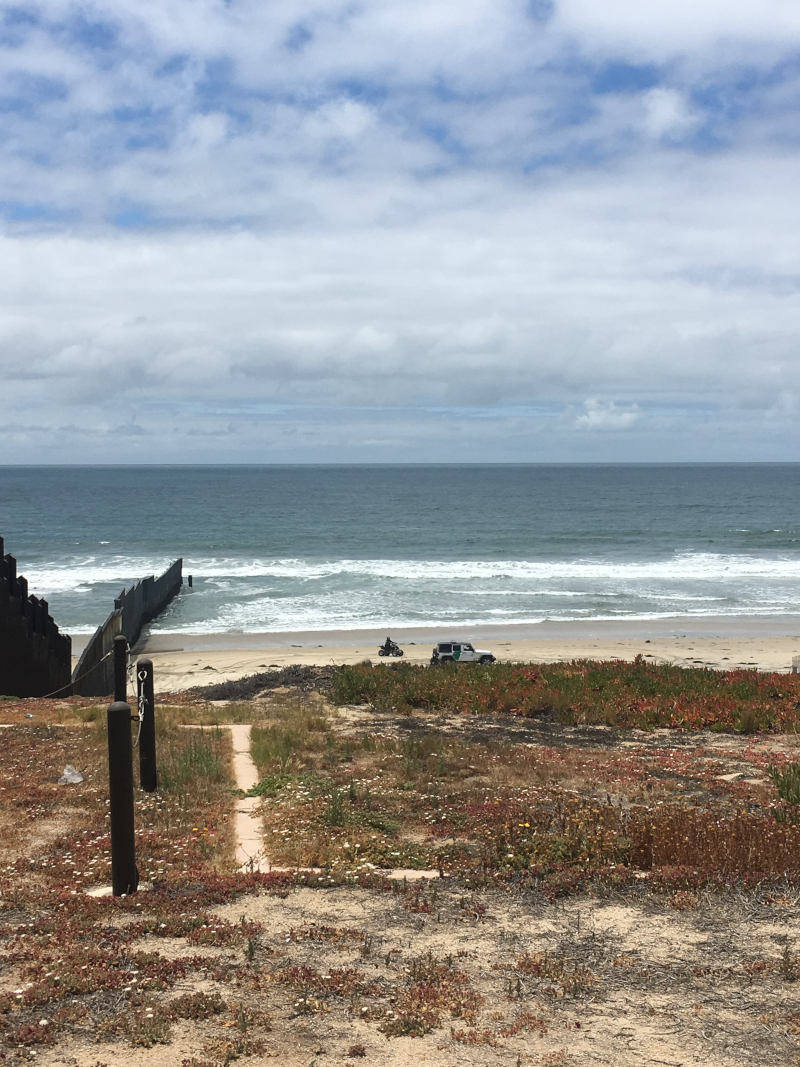
Border Patrol at Friendship Park. Photograph by the author.
Forging a Militarized Border Ecology
Friendship Park is a heavily surveilled public picnic area within Border Field State Park, a California State Park located on the southwestern edge of the Tijuana River National Estuarine Research Reserve. This is where the Tijuana River meets the Pacific Ocean, yet the beach landscape is disturbed by a series of border security infrastructures. Former First Lady Patricia Nixon dedicated Friendship Park in 1971 to serve as a bi-national park—where people on both sides could freely enjoy the transborder space—honoring the “friendship” between the U.S. and Mexico. In her inaugural speech, she said, “may there never be a fence between these two great nations so that people can extend a hand in friendship” (del Castillo and Morones 2012: 75). Contrary to its name, today, there is nothing friendly about Friendship Park. An amalgamation of California State Park facilities—including restrooms, cement picnic benches, a beach viewing area, and parking lot—coexist with the Department of Homeland Security’s border security infrastructure projects further, dividing it from the Mexican side, El Parque de la Amistad.
The first highly visible border fence erected upon Friendship Park’s landscape was constructed from recycled steel plates utilized by the U.S. military during the Vietnam War. In the mid-2000s that fence was ultimately replaced, and the second layer of fencing, funded by the 2006 Secure Fence Act, was later added to the border landscape. Yet, the military’s presence at the estuary dates back to 1910 during the Mexican Revolution when the 11th Calvary established Camp Hearn to patrol the United States-Mexican border. Between 1929 and 1941, the United States Navy established a machine gun range and an auxiliary landing field adjacent to the now estuarine grounds and Tijuana River’s delta. Today, the landing field is where the Naval helicopter pilots train—they circle around the estuary and park hour after hour day after day. The estuary was also an actual dump for the City of Imperial Beach in California. Environmentalists sought out the preservation of the Tijuana River Estuary as early as the 1960s, but it was not until 1982 that the estuary officially received environmental protection through the United States Department of Commerce’s National Estuarine Sanctuary Program. Walking through the estuary today, one finds broken glass scattered across the grounds—remnants of the former city dump. From military use to landfill and ultimately a conservation zone, land at both Border Field State and Friendship Park has been contested since the parks’ inception.
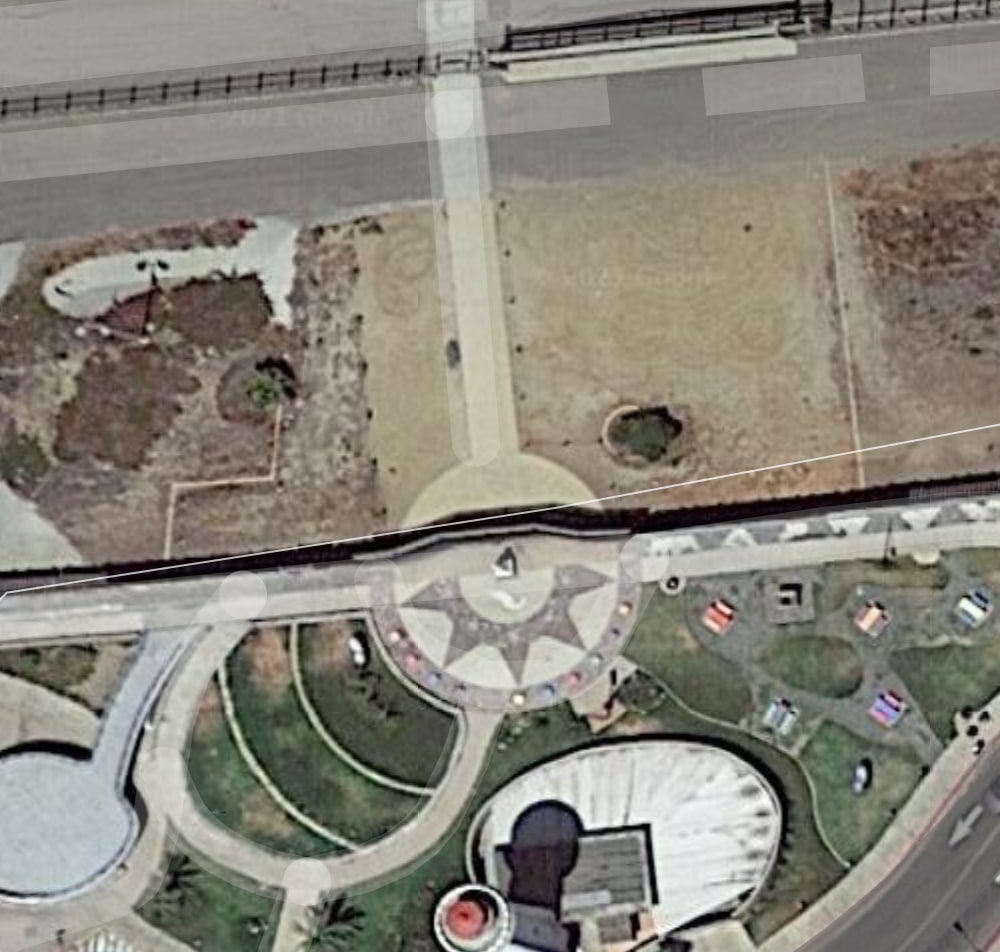
Aerial view of “bi-national” Friendship Park and El Parque de La Amistad and Friendship Circle. Google Maps.
Disrupting Border Security Infrastructure Projects
Despite the military, the series of border fencing, and the ominous presence of the Border Patrol, Friendship Park and its Mexican side, El Parque de La Amistad in Tijuana, are epicenters for various transborder political rallies, visual art installations, and transborder performances. On an early morning in May 2017, I headed to Friendship Park with my friend Gustavo to attend the 2017 Fandango Fronterizo [1], a Son Jarocho transborder music festival that happens annually.
The Fandango Fronterizo is a transborder performance of acoustic solidarity amid border security figures and infrastructures. On the U.S. side, musicians and spectators alike gather to play, dance, and sing to Son Jarocho music in the interstice between both border fences at Friendship Park in an area known as Friendship Circle. Marked by a cement half circle on the ground divided by an oxidized steel beam and mesh border fence, Friendship Circle transcends into Mexico. During transborder events like the Fandango Fronterizo, it is a space where musicians and other specters can gather.
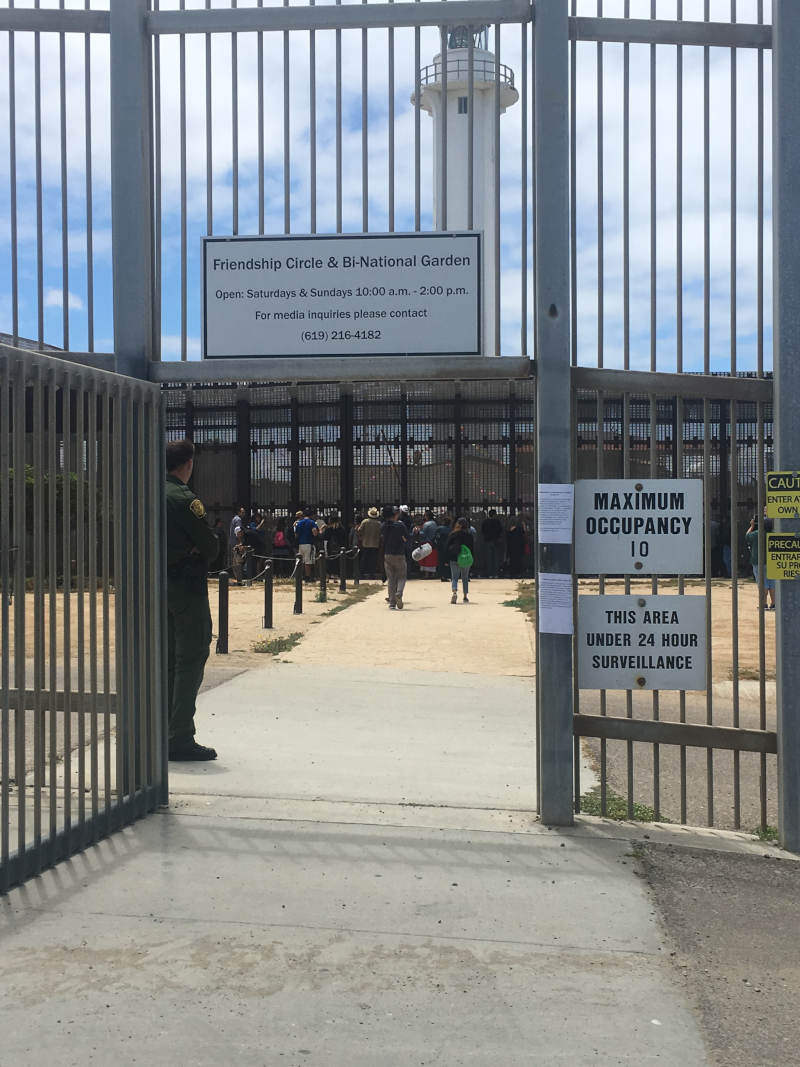
Entrance to Friendship Circle, US Side. Photograph by the author.
As I steadily drove through Border Field State Park to reach Friendship Park, I trailed behind a group of predominantly white tourists on an equestrian tour. The park’s trails accommodate horseback riding. It is common to encounter groups of six to eight tourists dressed as pseudo cowboys and cowgirls on a horseback adventure to the beach. Gustavo, who is undocumented, grew anxious. He noticed the overwhelming presence of Border Patrol vehicles in the surrounding hilltops and hidden along the park’s trails. For undocumented Americans like himself, the transborder festival was a rare opportunity to gather with loved ones and have a nice time, which is why he wanted to accompany me that day. At these events, there is a great public presence that prevents the Border Patrol from harassing or detaining anyone suspect of “illegal” presence in the United States. Still, at the 2017 Fandango Fronterizo, Border Patrol agents were everywhere—they enclosed Friendship Circle to a mere square of no more than 30 feet on each of its sides.
Despite the perpetual watchful eye of border agents and security infrastructures, this area is at times open for public transborder events, like the Fandango Fronterizo. Activists, artists, and community leaders often organize performances, installations, and gatherings at Friendship Circle with the intent to challenge and disrupt border security infrastructure projects. Yet these events are always conditional and up to the discretion of the Border Patrol. At the Fandango Fronterizo, for example, just as one gets comfortable enveloped in the music, begins to dance, and forgets about the looming presence of the border patrol and surveillance cameras, the fandango abruptly ends without much warning because the allocated time is too short. Participants feel that it ends too soon. As a Fandango musician described to me, “just like that, all the music stops, and things slow down,” because the Department of Homeland Security defines when, where, for how long, and how many can participate in these transborder events. When the Fandango does end, things just go back to their “ordinary” social and natural orders—heavily militarized border surveillance. For those that can cross borders, the fandango continues on the Mexican side.
Envisioning a Different Kind of Park
In direct contrast to the militarized border surveillance on the U.S. side, murals and gardens attempt to personalize the border fence cutting through the El Parque de La Amistad on the Mexican side. For years, Mexican and Chicana/o/x artists have re-appropriated this section of the border, transforming it from a site of separation to one of congregation and political protest. Prior to the border fences, El Centro Cultural de La Raza’s Border Art Workshop/Taller de Arte Fronterizo organized transborder installations. Today, the unique triangular shape of the border fence pillars provides two separate canvases for multisided, multicolored, and multi-thematic murals. Artists have also readapted the flat metal plates on top of the border fence as a canvas for their murals. Pastel pink, blue, red, yellow, and green colored cement benches faced away from the fence align a walkway that runs along El Parque de la Amistad and down to a boardwalk leading to the beach. The themes and message of the artworks on this side of the fence offer an imagination of a world without such border walls.
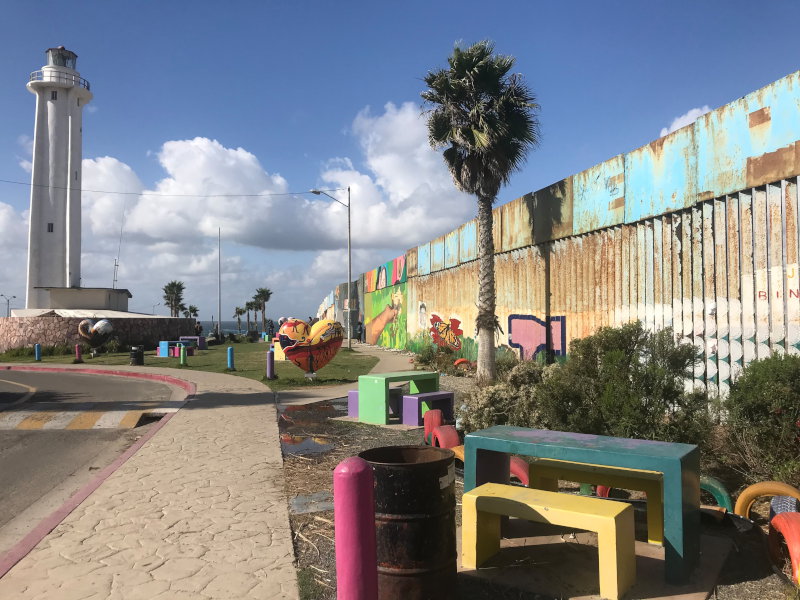
El Parque de La Amistad, Playas Tijuana, Mexico. Photograph by the author.
Gardens with rosemary, citronella, roses, succulents, and other plants abut the border fence. These plants formed part of a once-thriving binational community garden—cared for by the Friends of Friendship Park. The Trump administration’s push to build a taller border wall destroyed the binational garden and a 30-foot (9-meter) wall further endangers the local beach and the river ecology. Whether it be called a wall or a fence, these border security infrastructure projects tear apart any lingering hope for friendly ties between the U.S. and Mexico. Such infrastructures dismantle any bi-national connections, like those forged by Armando and his in-laws or the Friends of Friendship Park’s community bi-national garden. Yet, there is still hope for a bi-national park in the near future.
Conclusion: Build That Park
Friends of Friendship Park envisions a true bi-national park with no border barriers. With their “Build That Park” campaign they hope to further disrupt any border security infrastructure projects threatening the future of the park and the beach ecology. Pedro Rios, director of the American Friends Service Committee and member of Friends of Friendship Park, considers stopping construction at Friendship Park as “the essential first step in permanently ending the kinds of projects that for decades have caused so much harm to border communities.” With Trump out of the White House, the possibility to establish a bi-national park seems more attainable than ever before. Yet, before we praise Biden, it is important to remember that it was a Democrat who instituted the policy that militarized this section of the U.S.-Mexican border. Also, it was a Democratic President whose treatment of immigrants earned him the title “Deporter in Chief.” So, with the new Biden Administration, how do we ensure that no more border barriers are constructed? How do we begin to tear down these divisive walls? I don’t have these answers, but it starts with imagining the future we want and supporting those in the fight.
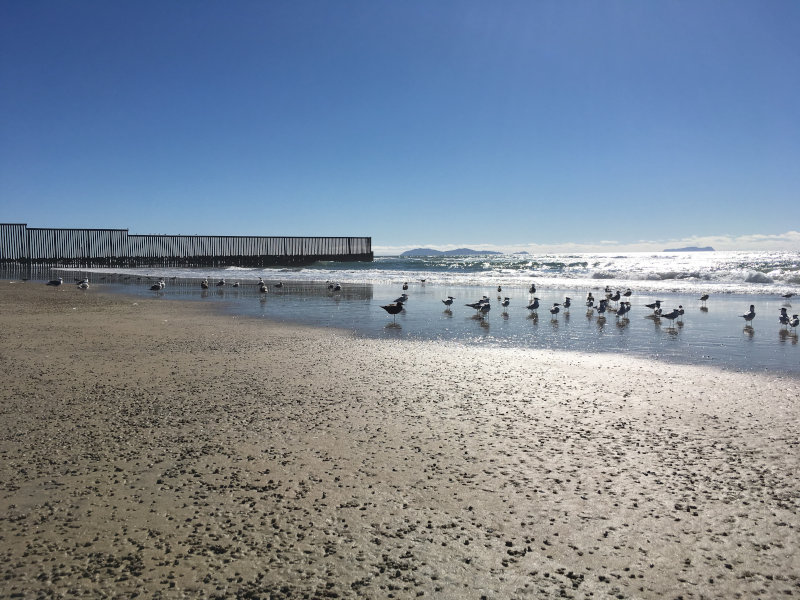
Where the border fence between San Diego, California and Tijuana, Mexico meets the Pacific Ocean. Photograph by the author.
Footnotes
[1] Fandangos are community celebrations.
Bibliography
“About – Fandango at the Wall.” Accessed January 28, 2021. http://fandangowall.com/about.
“Sign the Petition.” Accessed January 28, 2021. https://www.change.org/p/joe-biden-build-that-park-on-the-us-mexico-border.
“COVER STORY: Art That Crosses the Line: Dozens of Artists on the San Diego-Tijuana Border Take up the Cause of Illegal Immigrants with Attention-Getting Works.” Los Angeles Times, October 20, 1991. https://www.latimes.com/archives/la-xpm-1991-10-20-ca-85-story.html.
“Equestrians — Tijuana Estuary: TRNERR.” Accessed January 28, 2021. https://trnerr.org/plan_a_visit/equestrians/.
“Fandango Fronterizo 2017 – YouTube.” Accessed January 28, 2021. https://www.youtube.com/watch?v=1ai6BUODYLI&feature=emb_logo.
Morones, Enrique, and Richard Griswold del Castillo. Border Angels: The Power of One. 2nd ed. San Diego: San Diego State University Press, 2015.
“Let’s Build a Binational Park | BUILD THAT PARK!” Accessed January 28, 2021. https://www.buildthatpark.org.
“U.S. Side of a Binational Garden Bulldozed.” San Diego Union-Tribune, January 9, 2020. https://www.sandiegouniontribune.com/news/border-baja-california/story/2020-01-09/binational-garden-between-tijuana-and-san-diego-destroyed-in-the-united-states-side.
The White House. “Proclamation on the Termination of Emergency with Respect to the Southern Border of the United States and Redirection of Funds Diverted to Border Wall Construction,” January 21, 2021. https://www.whitehouse.gov/briefing-room/presidential-actions/2021/01/20/proclamation-termination-of-emergency-with-respect-to-southern-border-of-united-states-and-redirection-of-funds-diverted-to-border-wall-construction/.
